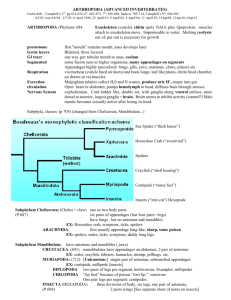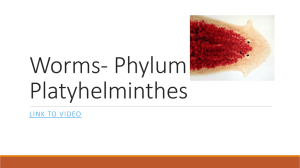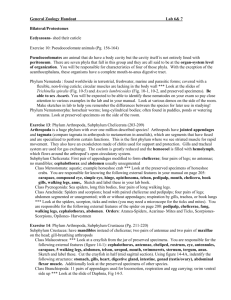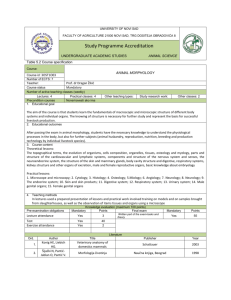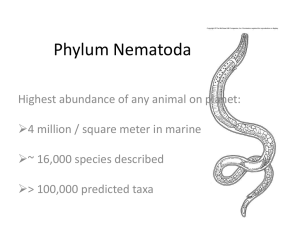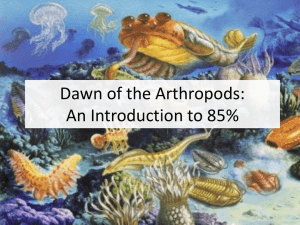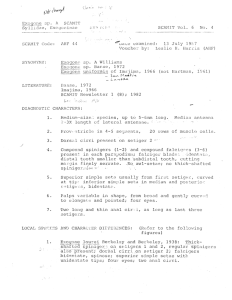Ch29
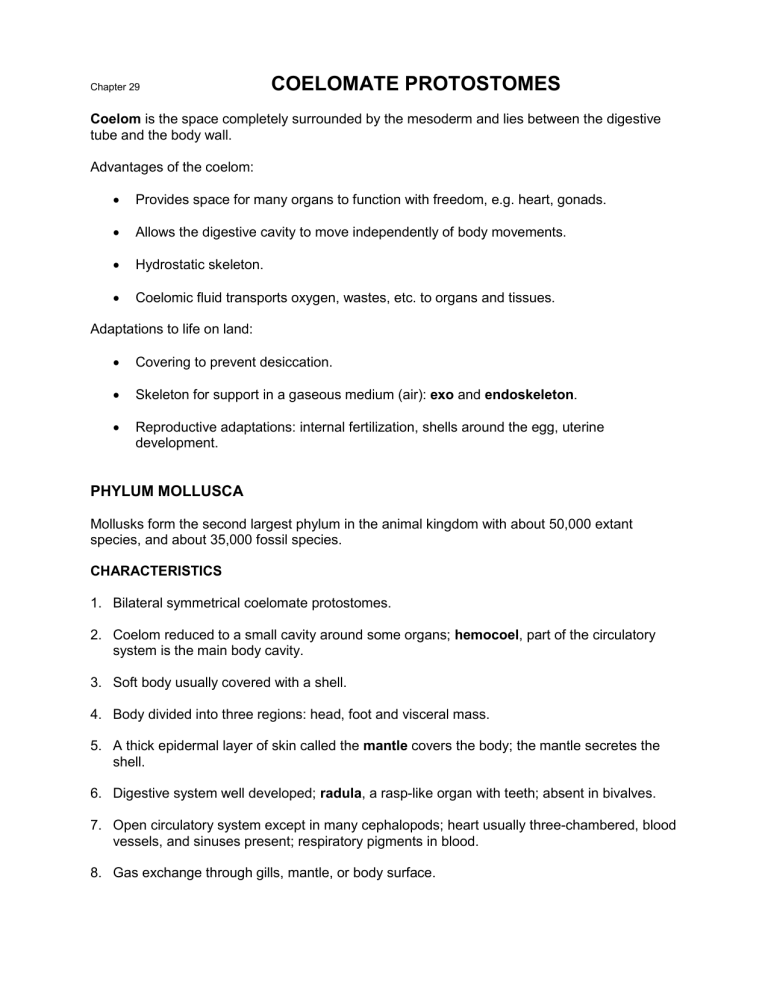
Chapter 29
COELOMATE PROTOSTOMES
Coelom is the space completely surrounded by the mesoderm and lies between the digestive tube and the body wall.
Advantages of the coelom:
Provides space for many organs to function with freedom, e.g. heart, gonads.
Allows the digestive cavity to move independently of body movements.
Hydrostatic skeleton.
Coelomic fluid transports oxygen, wastes, etc. to organs and tissues.
Adaptations to life on land:
Covering to prevent desiccation.
Skeleton for support in a gaseous medium (air): exo and endoskeleton .
Reproductive adaptations: internal fertilization, shells around the egg, uterine development.
PHYLUM MOLLUSCA
Mollusks form the second largest phylum in the animal kingdom with about 50,000 extant species, and about 35,000 fossil species.
CHARACTERISTICS
1. Bilateral symmetrical coelomate protostomes.
2. Coelom reduced to a small cavity around some organs; hemocoel , part of the circulatory system is the main body cavity.
3. Soft body usually covered with a shell.
4. Body divided into three regions: head, foot and visceral mass.
5. A thick epidermal layer of skin called the mantle covers the body; the mantle secretes the shell.
6. Digestive system well developed; radula , a rasp-like organ with teeth; absent in bivalves.
7. Open circulatory system except in many cephalopods; heart usually three-chambered, blood vessels, and sinuses present; respiratory pigments in blood.
8. Gas exchange through gills, mantle, or body surface.
9. Nervous system consists of a pair of ganglia, with nerve cords; ganglia forming a nerve ring in gastropods and cephalopods.
10. Sensory organs present (touch, smell, taste, equilibrium, and vision in some); eyes highly
developed in cephalopods.
11. Sexes separate in most; fertilization external; many species pass through one or several
larval stages.
CLASS POLYPLACOPHORA or chitons. Animals with segmented shells made of 8 plates; head reduced; broad foot used in locomotion.
CLASS GASTROPODA includes snails, slugs and nudibranchs. Marine, freshwater and terrestrial animals with body and shell coiled in some species (torsion); pulmonate mantle in terrestrial species; well developed head with tentacles and eyes; broad flat foot used in locomotion.
CLASS BIVALVIA includes clams, oysters and mussels. Marine and freshwater animals with a two-part shell hinged dorsally; lack head and radula; suspension feeders.
CLASS CEPHALOPODS, octopods and squids. Marine and predatory animals with the foot modified into tentacles, bearing suckers; tentacles surround the mouth of a large head; mouth with a horny beak and radula; eyes are very well developed; lack shell. Squids can learn to some degree.
PHYLUM ANNELIDA
There are about 15,000 species in the phylum. They may be marine, freshwater or terrestrial herbivores, carnivores, parasites, scavengers and suspension feeders.
CHARACTERISTICS
1. Bilateral symmetry; body tubular and segmented (metamerism).
2. Coelom, body wall and many internal organs segmented by septa; well developed muscles form the body wall.
3. Setae or parapodia present on each segment; absent on leeches.
4. Complete digestive system, unsegmented.
5. Gas exchange through skin or gills.
6. Closed circulatory system; blood pigments transports oxygen.
7. A pair of metanephridia in each segment.
8. Nervous system made of simple brain made of two ganglia, double ventral nerve cord and sense organs (touch, eyes); pair of ganglia and nerves repeated in each segment.
9. Reproduction sexual; hermaphroditic or separate sexes.
CLASS POLYCHAETA. Polychaetes are characterized by having a well-developed head with eyes and antennae; paired appendages (parapodia) with setae on most segments; sexes separate. Mostly marine animals; about 10,000 species.
CLASS OLIGOCHAETA. Terrestrial or freshwater worms characterized by having poorly developed head, few setae per segment, hermaphroditic, and have a clitellum.
CLASS HIRUDINAE. Mostly freshwater blood-sucking parasites, some species adapted to humid terrestrial habitats; lack setae and parapodia; have a definite number of segments and an anterior and posterior sucker for attachment.
PHYLUM ARTHROPODA
The largest and most diverse phylum with over one million species found in all habitats.
CHARACTERISTICS
1. Bilateral symmetry.
2. Body segmented into head, thorax and abdomen; in some head and thorax fuse into a cephalothorax.
3. Coelom small and filled with fluid and internal organs.
4. Jointed appendages that function in locomotion, feeding or copulatory organs.
5. Exoskeleton secreted by the epidermis and made of protein, chitin, lipids and minerals; periodic molting to allow growth.
6. Respiratory system varied: marine forms use gills; terrestrial species have a system of branching tubes called tracheae or plate-like structures called book lungs.
7. Nervous system consists of a brain, double ventral nerve cord with many ganglia; sense organs well developed. Insects and crustaceans have compound eyes.
8. Muscular system well developed; muscles for rapid motion.
9. Circulatory system open with a dorsal tubular heart that pumps the hemolymph.
10. Excretory system varied in the different subgroups. Malpighian tubules in insects.
11. Reproduction sexual and sexes separate.
SUBPHYLUM CHELICERATA
First pair of appendages, the chelicerae, are used to manipulate food; cephalothorax and abdomen; lack mandibles and antennae. Classes Merostomata and Arachnida.
SUBPHYLUM CRUSTACEA
Mandibles present; two pairs of antennae; biramous appendages. Class
Malacostraca.
SUBPHYLUM UNIRAMIA
Mandibles present; single pair of antennae; uniramous appendages. Classes
Insecta, Chilopoda and Diplopoda.
Arachnids comprise about 60, 000 species. They are characterized by having a cephalothorax, four pairs of legs, chelicerae, and no antennae; most are terrestrial carnivores.
There are about 32,000 species of Crustaceans . They have a cephalothorax covered with a carapace, two pairs of biramous antennae, one pair of biramous legs per segment, and mandibles and maxillae. Antennal glands located on the head remove metabolic wastes.
Statocysts help in maintaining balance.
The Class Insecta is the most successful group of animals. There are about 750,000 described species. Their body is divided into head, thorax and abdomen, have three pairs of legs, one pair of uniramous antennae, have tracheal tubes for gas exchange, and undergo metamorphosis.
Metamorphosis may be complete (egg, larva, pupa, adult) or incomplete (several nymphs that resemble the adult).
Insecta are extremely successful due to their adaptations: exoskeleton, sense organs, segmentation, ability to fly, reproductive strategies, mechanisms of defense, etc.
Centipedes belong to the class Chilopoda . There are about 3,000 species of centipedes. They have a head and segmented body, one pair of legs per segment, one pair of uniramous antennae, and mandibles and maxillae.
7,500 species of millipedes form the class Diplopoda . They have a head and segmented body, two pairs of legs per segment, a pair of uniramous antennae, mandibles and maxillae.
